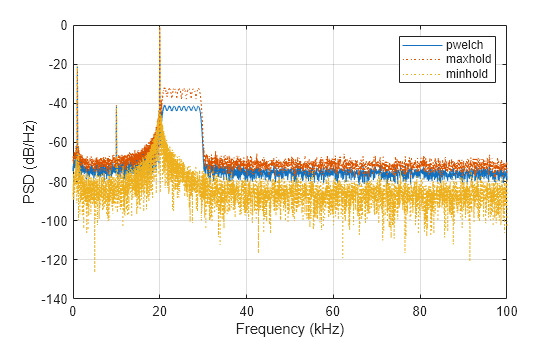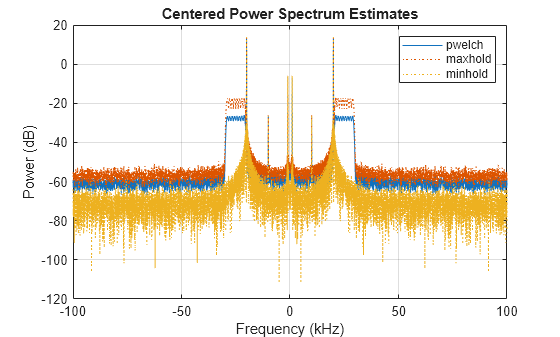韦尔奇频谱估计值
创建一个信号,该信号由三个含噪正弦波和一个以 200 kHz 进行 0.1 秒采样的啁啾组成。这些正弦波的频率分别为 1 kHz、10 kHz 和 20 kHz。这些正弦波具有不同振幅和噪声电平。无噪声啁啾的频率从 20 kHz 开始,并在采样期间线性增大到 30 kHz。
Fs = 200e3; Fc = [1 10 20]'*1e3; Ns = 0.1*Fs; t = (0:Ns-1)/Fs; x = [1 1/10 10]*sin(2*pi*Fc*t)+[1/200 1/2000 1/20]*randn(3,Ns); x = x+chirp(t,20e3,t(end),30e3);
计算信号的韦尔奇 PSD 估计值以及最大值保持和最小值保持频谱。绘制结果。
[pxx,f] = pwelch(x,[],[],[],Fs); pmax = pwelch(x,[],[],[],Fs,'maxhold'); pmin = pwelch(x,[],[],[],Fs,'minhold'); plot(f/1000,pow2db(pxx)) hold on plot(f/1000,pow2db([pmax pmin]),':') hold off xlabel('Frequency (kHz)') ylabel('PSD (dB/Hz)') legend('pwelch','maxhold','minhold') grid

重复此过程,这次计算中心化功率谱估计值。
[pxx,f] = pwelch(x,[],[],[],Fs,'centered','power'); pmax = pwelch(x,[],[],[],Fs,'maxhold','centered','power'); pmin = pwelch(x,[],[],[],Fs,'minhold','centered','power'); plot(f/1000,pow2db(pxx)) hold on plot(f/1000,pow2db([pmax pmin]),':') hold off xlabel('Frequency (kHz)') ylabel('Power (dB)') legend('pwelch','maxhold','minhold') title('Centered Power Spectrum Estimates') grid
